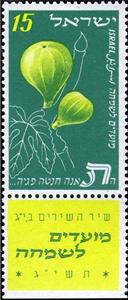Stamp with Collectible Margin: Fig (Ficus carica) (Israel 1952)
Fig (Ficus carica) (Israel 1952)
03 September (Israel ) within release Festival 1952 goes into circulation Stamp with Collectible Margin Fig (Ficus carica) face value 15 Israeli pruta
| Stamp with Collectible Margin Fig (Ficus carica) in catalogues | |
|---|---|
| Michel: | Mi: IL 73T |
| Stamp Number: | Sn: IL 66T |
| Yvert et Tellier: | Yt: IL 58T |
| Stanley Gibbons: | Sg: IL 69T |
Stamp with Collectible Margin is square format.
Also in the issue Festival 1952:
- Stamp - Festival 1952 - Figs face value 15;
- Stamp - Festival 1952 - Lily face value 40;
- Stamp - Festival 1952 - Dove face value 110;
- Stamp - Festival 1952 - Nut cluster face value 220;
- Stamp with Collectible Margin - Easter lily (Lilium longiflorum) face value 40;
- Stamp with Collectible Margin - Fig (Ficus carica) face value 15;
- Stamp with Collectible Margin - Lambert's Nut (Corylus maxima) face value 220;
- Stamp with Collectible Margin - Pigeon in Front of Reeds face value 110;
Stamp with Collectible Margin Fig (Ficus carica) it reflects the thematic directions:
A festival is an event celebrated by a community and centering on some characteristic aspect or aspects of that community and its religion or cultures. It is often marked as a local or national holiday, mela, or eid. A festival constitutes typical cases of glocalization, as well as the high culture-low culture interrelationship. Next to religion and folklore, a significant origin is agricultural. Food is such a vital resource that many festivals are associated with harvest time. Religious commemoration and thanksgiving for good harvests are blended in events that take place in autumn, such as Halloween in the northern hemisphere and Easter in the southern.
In botany, a fruit is the seed-bearing structure in flowering plants (also known as angiosperms) formed from the ovary after flowering. Fruits are the means by which angiosperms disseminate seeds. Edible fruits, in particular, have propagated with the movements of humans and animals in a symbiotic relationship as a means for seed dispersal and nutrition; in fact, humans and many animals have become dependent on fruits as a source of food. Accordingly, fruits account for a substantial fraction of the world's agricultural output, and some (such as the apple and the pomegranate) have acquired extensive cultural and symbolic meanings. In common language usage, "fruit" normally means the fleshy seed-associated structures of a plant that are sweet or sour, and edible in the raw state, such as apples, bananas, grapes, lemons, oranges, and strawberries. On the other hand, in botanical usage, "fruit" includes many structures that are not commonly called "fruits", such as bean pods, corn kernels, tomatoes, and wheat grains. The section of a fungus that produces spores is also called a fruiting body.
The New Year is the time or day at which a new calendar year begins and the calendar's year count increments by one. Many cultures celebrate the event in some manner. In the Gregorian calendar, the most widely used calendar system today, New Year occurs on January 1 (New Year's Day, preceded by New Year's Eve). This was also the first day of the year in the original Julian calendar and the Roman calendar (after 153 BC)
Flora is the plant life occurring in a particular region or time, generally the naturally occurring or indigenous—native plant life. The corresponding term for animal life is fauna. Flora, fauna and other forms of life such as fungi are collectively referred to as biota. Sometimes bacteria and fungi are also referred to as flora, as in the terms gut flora or skin flora.




